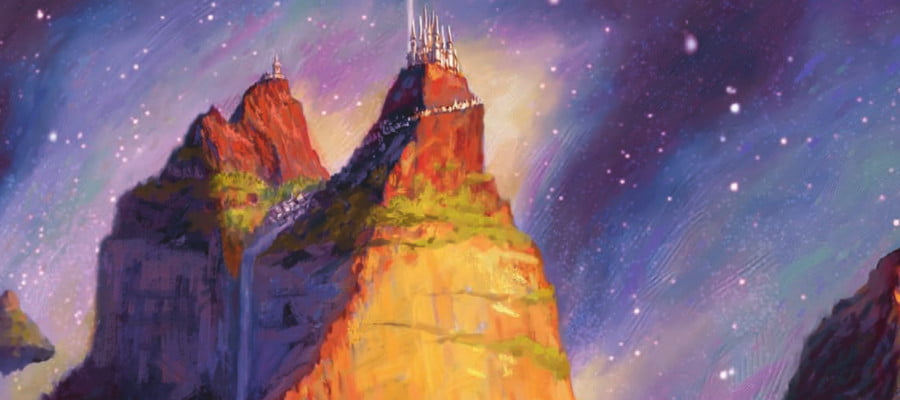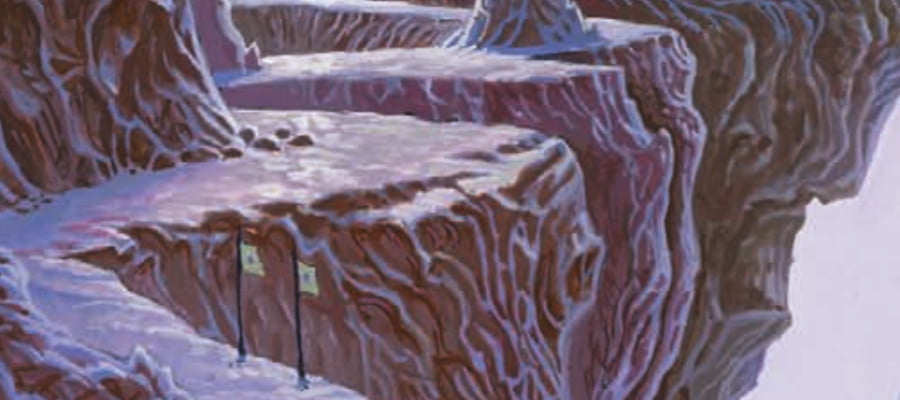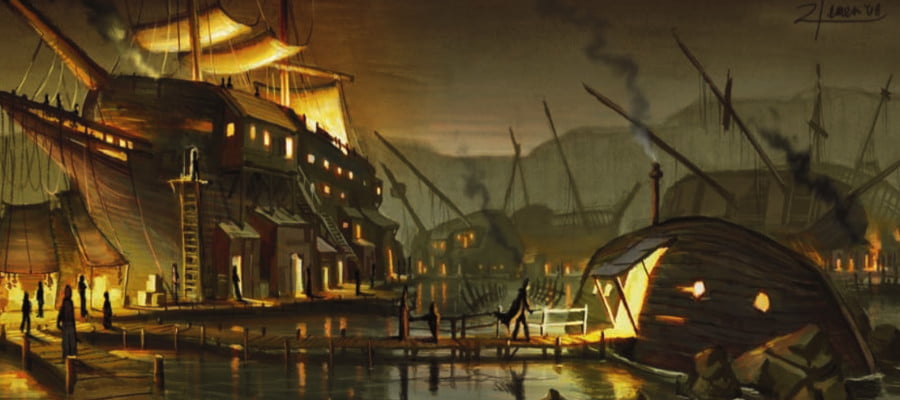Where do half-orcs come from?
Well that’s not a hard question, not really. The answer is they come from orcs, and humans. And that’s all the narrative requires for you to get a half orc. One or more orcs, one or more humans, and the whole thing sorts itself out. Orcs, and humans have worked out the systems for it and they’re largely self-regulating.
But that’s not really the question, not really. The question is where do half-orc characters come from, and subsequently, how do half-orc characters feel about the world they’re in?
Let’s talk about Half-Orcs, and about Orcs, and about Cobrin’Seil, and about the stories people tell one another about the things they don’t know.

Glossary Note: Conventionally, the term used in D&D for this mechanical package is race. This is the typical term, and in most conversations about this game system, the term you’re going to wind up using is race. For backwards compatibility and searchability, I am including this passage here. The term I use for this player option is heritage.
The Half-Orc, Mechanically
I already wrote an article about the origin point of Orcs, and I wrote a little about the way they handle games. In those articles, I did write about the way orcs could be seen, and definitely a definitive origin point for the orcs in the world, but I didn’t really tackle the idea of how they work in Cobrin’Seil. It is where we get the now-maybe-overused phrase made of meat to describe a culture who’s meant to be a natural byproduct of evolutionary process.
In pure mechanical terms, the Half-Orc is a bit of an odd orphan. See, the way I handle orcs in Cobrin’Seil is that half-orcs aren’t mechanically distinct enough from their human or orc forebears. Rather, the existing ‘half-orc’ mechanical package is the Orc heritage, and a half-orc can be mechanically either a human, or an orc, and be treated as either by the rules. This does technically make them more powerful but it’s not something you can do a lot to abuse, I don’t care that much. This mechanical proximity is important to me for the worldbuilding – Orcs and Humans are cousin species, and that means that they are already existing between one another in a form of variance – so a half-orc may look like one and mechanically operate like the other, and that’s totally fine.
But let’s talk about that culture thing, instead.

The Story Told About
The most widespread, most common heritage on the continent of Bidestra in Cobrin’Seil is humans. Humans made the King’s Highway that reaches from corner to corner of the continent, and human cities are dotted about the world. Therefore, when people talk about ‘the general’ view of any given culture, what that really means is ‘here is what humans think about this culture,’ and often, ‘here’s is what humans wrote about this culture a century ago, and haven’t really considered since.’
The story then, about half-orcs, as reflected by common human wisdom, is that orcs are strange raiders who live around human settlements, attacking them at random. These orcs therefore, must therefore, from time to time, steal away human women (and, the stories go, it is always women), to ‘have their way with.’ This is why nobles are encouraged to be extremely harsh with these bandits, to ensure that they do not fester or endanger the good and virtuous culture of humans.
Since Orcs don’t have villages or settlements, they really must be just roaming bandits, nomadic violence agents that steal from the cultures they pass by. They love to burn things, burning down villages they overtake, and stealing away the children, howling and baying in the flames as they endanger everything you hold dear.
They do not feel fear or pain. They do not care about buildings or culture. They are a destructive, consuming force. Some people imagine that they’re the result of an evil wizard, cursing the highway, and ensuring that humans must always be vigilant against this parasitism.
These are the worst stories of the worst of the orcs.
They are also complete nonsense.

The Story Of the Tellers
But that’s the narrative people share, that’s not the actual culture.
Orcs have settlements. They’re nowhere near the highways, nowhere near human spaces. Orcs live in spaces where other heritages avoid, because orcs are tougher and more dangerous than most cultures around them. Orc settlements are also spread out; you may consider a home literally twenty meters away as your ‘neighbour,’ – but to orcs, a house could be a half kilometer away and that journey is meaninglessly small. Orcs can run distances, carrying pack, that humans normally would consider riding distance.
Orc settlements are therefore much more about big common structures. Some examples include big fire-pits made for parties that may be mistaken as quarries, large treehouses for travellers to sleep in over time, or cultivated fields with mapped spaces for a trade-meet. There’s absolutely a community around that central location, but people are distant enough that they seem unrelated to human explorers in the location. They are also often integrated into the landscape to the extent that human explorers can miss them entirely.
Because of this, human explorers who were accounting for the existence of orcs have no idea that the orc communities are even there. This means that the only representatives of orc communities most human explorers conceive of are the bandits who hang around the highways… who are, themselves, outcasts from orc society. They are, essentially, the criminals of the orc communities, and turns out, that skews perspective on things.
But what about the ‘orcs like to burn things’ and ‘orcs steal human children’ thing?

Well, there’s a grain of truth to that, but it’s tied to the Orc communities’ idea of The Responsibility of Death. If you kill someone, in the orcish communities, you are responsible for ensuring that death is a good one. This means that you need to ensure the body is properly dealt with, and that the children are properly provided for. Sometimes this means bodies get buried – but more likely, with the common Orc clans today, they are most likely to burn the bodies, while singing their death hymns.
The children in this situation are adopted by the clan. After all, they deprived them of their parents, they owe the children a life. They have that responsibility. These children are often raised by the orcs, and when they reach adulthood, either remain in the community, or leave to return to human cultures. This helps fuel the stories of the ‘stolen children,’ in many cases. What’s really happening is that the orcs, rather than leave children to starve, will feed them and clothe them and raise them and respect them because that’s their responsibility. And if the children, grown, want to leave, and hate orcs forever because the orcs did absolutely kill their parents, that’s fine.
Because it was your responsibility.
They don’t always, of course. Some grapple with the complexity of it. Some consider it as an orc would: A conflict happened, someone innocent was involved, the victor gave them a chance at life.
There’s also a direct causal relationship here: Orcs don’t take battles or raids lightly, because they cost. They cost time and effort and food and resources to raise all the children involved. It takes time to burn all the bodies, to scatter the ashes, to sing the songs that remember the days. War is not fast, and when you are doing these things, you are vulnerable. These kind of things happen when there are human incursions into orc territory that can’t be reconciled, where aggression is met with aggression and conflict breaks out. Orcs, by default, will avoid these conflicts, because they represent a cost. Not the fighting – they don’t think of that, the fighting is probably easier, from where they stand. It’s these longer, infrastructural costs, because you slay a human, you are now required to raise that human’s children, and do a good job.
(Incidentally, orc same-sex couples in their communities are often known as people who can do this duty, and become specialised in the task of helping to rear traumatised kids.)
And that’s where half-orcs come from.
Typically, at least.
Typically, half-orcs happen because there are humans in orc settlements. They live there, they grow up there, they have relationships there, and they have kids there. Some of these humans were born there. For the most part, orcs don’t see humans as that different to orcs. Half-orcs happen because humans fall in love with orcs and vice versa.
Half-orcs are comparatively unique, of course; orcs will rear the children of any conflict they have, but other cultures can’t interbreed with orcs in the same way.

Why Do It This Way?
Like, why do we have the rumours about half-orcs that replicate the existing fantasy structure? Why do we have room in this story space for well, ‘the basic’ narrative?
Part of it is that Half-Orc players often want the misunderstanding. They want to have a general disposition of the world to resist. That’s something players want to engage with, but by using half-orcs for it, I don’t have to replicate the existing real-world racist structures in my world. I don’t want players to think about the common (white-dominated cultural view of) stereotypes about, like, African cultures when they look at Orcs and their half-orcs (because biracial people don’t get tusks).
The direct result then is that half-orcs in Cobrin’Seil exist in a world where there’s a general idea across the most widespread culture, that half-orcs bring much of the baggage from stereotypes across other games. This means that players get to experience the moment of looking at the world, seeing a culture being explained one way, then realising that the simplified, nonsensible world so explained is in fact, humans telling stories about an outgroup, and that if you belong to that group, you understand and see the world differently.
This isn’t me going: Look at me, I’m teaching players about the racisms with my half-orcs. It’s much less high-minded than that. I find the way cultures explain one another really interesting, and I like it when the heritage you choose to play brings with it some knowledge about your world that means you are the expert on your reality in a way that other people aren’t.
What I want to do, when I finally get a map of Cobrin’Seil made (hahaha oh my god I am so bad at that), is to have overlaid versions of it; one form showing the highways and the national boundaries; another form, with the highways in place, showing the way that the clans of the orcs and the goblins and other widespread groups exist, completely ignoring the boundaries of these ‘nations.’
And if you’re a half-orc, you probably know what both are about.
2 Trackbacks